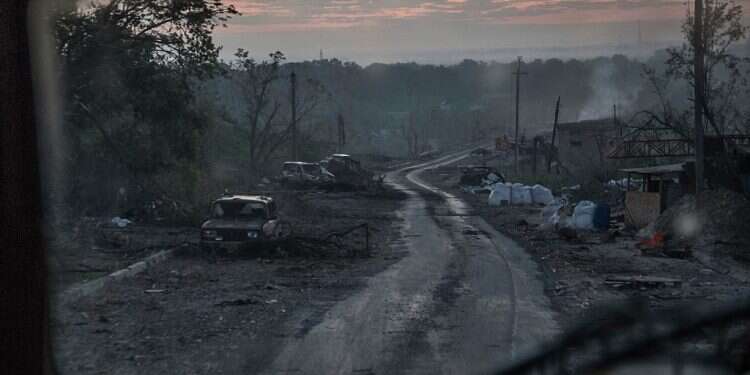KYIV, UKRAINE — Few people outside the industrial region of Donbas in Ukraine's east ever heard of Sievierodonetsk, a city of nearly 100,000.
It used to be a large chemical production center, with its industrial zone of factories and chimneys claiming nearly half of the city's territory. Now, it's a giant desolated battlefield in the very spotlight of the world. For weeks, Russia and Ukrainian militaries are waging cut-throat, brutal fighting in the city, throwing more and more troops in the grinder, with houses and districts changing hands all the time. Both sides are extremely exhausted and have sustained devastating losses. But none is ready to back down. As Russia keeps launching never-ending frontal attacks, it is also committing nearly all of its available resources to surround a large Ukrainian military grouping in the area and destroy it. Amid the dramatic battle, Ukraine so far manages to keep its nearly 10,000-strong garrison reinforced and combat-capable.
Follow Israel Hayom on Facebook, Twitter, and Instagram
Yet, the situation is still close to critical. And the outcome of the Battle of Sievierodonetsk will likely define the Russian campaign in Donbas, and, largely, the whole Russian war in Ukraine. The Battle of Donbas in Ukraine's east continues for more than 40 days. Russian attempts to encircle and destroy the whole of Ukraine's military grouping in the region (which is in fact most of Ukraine's armed forces) have not been successful. So with time, it has switched to much more narrow goals of creating several smaller death traps for the Ukrainian military instead of just one giant. In many ways, this happened due to Russia's lack of manpower for such a large operation, as well as fierce Ukrainian resistance.
The twin city of Sievierodonetsk and Lysychansk, a large industrial metropolitan area, is now the last patch of Ukraine's Luhansk Region still not seized by Russia. So in the last weeks, according to Ukrainian estimates, Russia has committed nearly 50% of its military power in Ukraine to surround the grouping and cut it off supplies.
That would be a major debacle for Ukraine's military and a huge blow to national morale. In late May, Russia seemed to be just a step away from severing the T1302 highway (commonly known as "the road of life") and closing the 40-kilometer-wide pocket. There have been doom and gloom in media in Ukraine and beyond, with loud calls to the Ukrainian military to withdraw troops from Sievierodonetsk and Lysychansk to save them from inevitable disaster.
But against expectations, the Ukrainian command decided to keep reinforcing the garrison and continue the fight. As a result, the Ukrainian military managed to not only stop Russia's dangerous advances to encircle the area but also in early June launch a series of successful counter-strikes in Sievierodonetsk that repulsed Russia back to the city's eastern part and took southern suburbs back under Ukrainian control.
In fact, the city that was almost generally considered lost suddenly saw the situation reversed. Some in Ukrainian media were so impressed that they were quick to nickname the June counter-strike "the miracle of Sievierodonetsk." As of now, fierce fighting in the city continues. According to local Ukrainian authorities, Sievierodonetsk has nearly 90% of its residential buildings destroyed or heavily damaged, and just between 10,000 and 15,000 civilians still hide in the city's shelters.
In the words of Luhansk region governor Serhiy Gaidai, "the silence comes only when cannons get reloaded." According to local accounts, Ukrainian forces are in control of nearly 40-50% of the city, and they have made the city's giant industrial zone, including what's left of the famous Azot chemical factory, its fortified base. In dense urban terrain and amid ruins, the Ukrainian military partly neutralizes Russia's supremacy in heavy artillery and air cover, exhausting Russian infantry in close combat.
Sievierodonetsk is standing, and Ukraine is also fortifying the defenses Lysychansk just to the west, a city on a higher ground that is belted by the Siverskiy Donets River hilly banks, which gives a big advantage to defenders. But still – Russia, according to intelligence, is concentrating fresh reserves to try and complete the area's encirclement. It has to fight just nearly 20 kilometers of its way to make the northern and southern strikes meet up and close the death trap. The Ukrainian military is in a dangerous and risky position, and the stakes are very high. If the trap is closed, a significant part of Ukraine's best forces will likely be completely exhausted and destroyed.
The future defense of the region's key fortresses – Slovyansk, Kramatorsk, Bakhmut, Avdiivka – would be gravely compromised. That would be a blow even more painful and impactful than the recent drama of Mariupol and the Azovstal garrison that had to fight on alone with no chances to break free.
Subscribe to Israel Hayom's daily newsletter and never miss our top stories!




